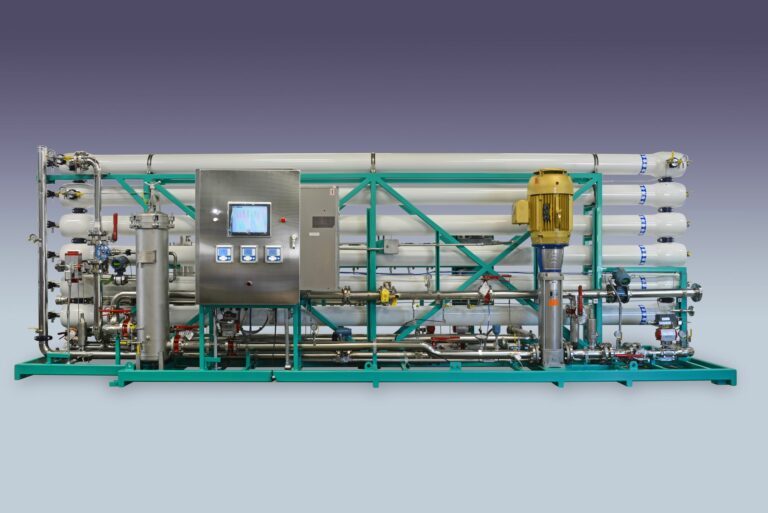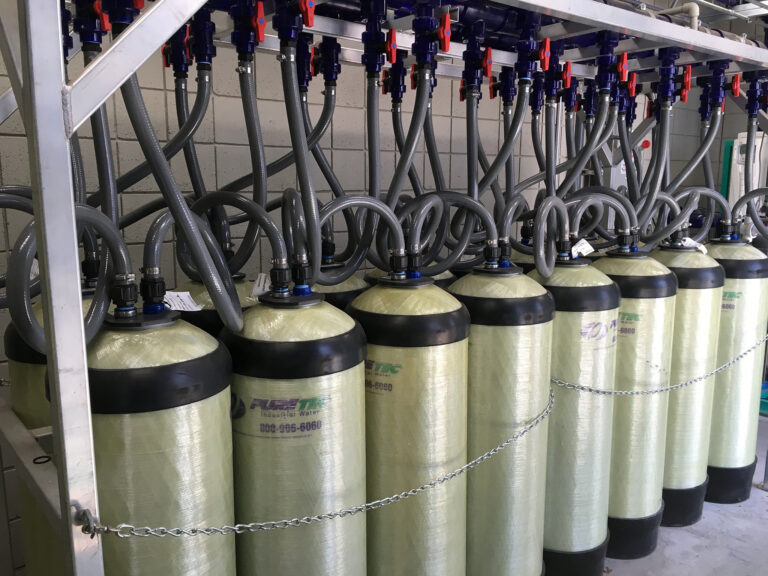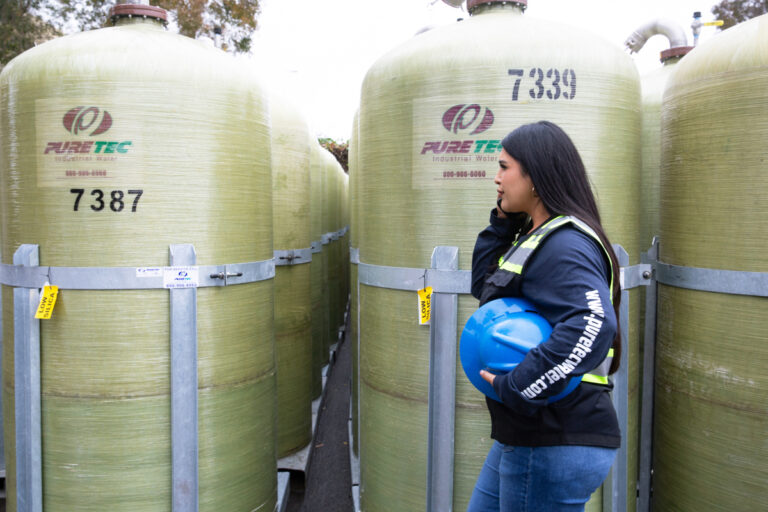What is deionization?
Deionization (or demineralization) simply means the removal of ions. Ions are electrically charged atoms or molecules found in water that have either a net negative or positive charge. For many applications using water as a rinse or ingredient, these ions are impurities and must be removed from the water.
Ions with a positive charge are called Cations and ions with a negative charge are Anions. Ion exchange resins are used to exchange non-desirable cations and anions with hydrogen and hydroxyl, respectively, forming pure water (H2O), which is not an ion.
How does ion exchange work?
Ion exchange resins are used to produce deionized (demineralized or DI) water. These resins are small plastic beads composed of organic polymer chains that have charged functional groups built into the resin bead. Each functional group has either a fixed positive or negative charge.
- Cation resin has a negative functional group and attracts positively charged ions.
- There are two types of cation resins – weak acid cation (WAC) and strong acid cation (SAC). Weak acid cation resin is used mainly in dealkalization and other unique applications. This paper focuses on explaining the role of strong acid cation resins used for producing deionized water.
- Anion resin has a positive functional group and attracts negatively charged ions.
- There are two types of anion resins – weak base anion (WBA) and strong base anion (SBA). Both types are used to produce deionized water, however, they have different characteristics.
- WBA resins do not remove silica, CO2 or neutralize weak acids and have a lower than neutral pH when used in a dual separate bed system.
- SBA resins remove all anions in the above table, including CO2, and have a higher than neutral pH when used in a dual separate bed system due to sodium leakage.
- Mixed bed resins use SAC and SBA resins combined.
To produce deionized water, cation resin is regenerated with Hydrochloric Acid (HCL). The Hydrogen (H+) is positively charged and attaches itself to the negatively charged cation resin bead. The anion resin is regenerated with sodium hydroxide (NaOH). Hydroxyl (OH-) is negatively charged and attaches itself to the positively charged anion resin bead.
Different ions are attracted to a resin bead with different strengths. For example, calcium is more strongly attracted to a cation resin bead than sodium would be. The hydrogen on the cation resin bead and the hydroxyl on the anion resin bead do not have a strong attraction to the bead. This is what allows ion exchange to take place.

Different type of ion exchange resins used in water treatment
As positively charged cations flow across cation resin beads, the cations are exchanged for hydrogen (H+). Likewise, as negatively charged anions flow across anion resin beads, the anions are exchanged for hydroxyl (OH-). When combined, the hydrogen (H+) and hydroxyl (OH-) form pure H2O.
Eventually, all the exchange sites on the cation and anion resin beads are used up and the tank no longer produces deionized water. At this point, the resin beads require regeneration to prepare them for use again.
Separate bed vs mixed bed
Demineralization therefore requires using at least two types of ion exchange resins to produce deionized water. One resin will remove positively charged ions and the other will remove negatively charged ions.
In a dual bed system, the cation resin is always first in line. As city water enters the tank filled with cation resin, all positively charged cations are attracted to the cation resin bead and exchanged for hydrogen. The negatively charged anions are not attracted to the cation resin bead and pass through.
For example, when calcium chloride is in the feed water, in solution, the calcium ion is positively charged and will attach itself to the cation bead and will release a hydrogen ion. Th chloride has a negative charge and, therefore, will not attach itself to the cation resin bead. The hydrogen, which has a positive charge, will attach itself to the chloride ion forming hydrochloric acid (HCl). The resulting effluent from the SAC exchanger will have a very low pH and much higher conductivity than the incoming feed water.
The effluent from the cation resin will consist of strong and weak acids. This acidic water will then enter a tank filled with anion resin, which will attract negatively charged anions, such as chloride, and exchange them for hydroxyl. The result is hydrogen (H+) and hydroxyl (OH-), which forms H2O.
In real-world conditions, a dual bed system does not produce true H2O due to “sodium leakage.” If sodium leaks past the cation exchange tank, then it combines with hydroxyl to form sodium hydroxide, which has high conductivity. Sodium leakage occurs because sodium and hydrogen have very similar attractions to the cation resin beads and sometimes the sodium ion does not exchange itself for a hydrogen ion.
In a mixed bed system, the strong acid cation and strong base anion resin are intermixed to effectively make the mixed bed tank act like thousands of dual bed units in one tank. The cation/anion exchange takes place over and over within the resin bed. Sodium leakage is addressed through the sheer number of repeated cation/anion exchanges. Using a mixed bed produces the highest quality deionized water possible.
How are ions measured?
Ions conduct electricity. Electrical current passes through water using ions as steppingstones to pass the current from one conductive ion to another. So, measuring the electrical conductance can effectively gauge the water’s ionic content. Fewer ions in the water makes passage of the electrical current more difficult. Water with lower conductivity values is considered more “deionized” than water with a high conductivity value.
Click here to download this as a pdf!
Also, make sure to watch our video on how our ion exchange tanks work!





